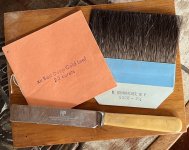Some of us remember sign-writers applying gold leaf to windows. Some of it still survives, although there are probably few signwriters now who can use it, or do hand lettering with a "quill". Properly applied, it can last for centuries. This is a long-ish read but fascinating (IMHO)
The Last Gold Beater in Venice
When I was in my late 20's I got interested in calligraphy and made halting attempts to learn to lay gold leaf on specially-prepared "size" on hand-made paper. I still have part of a book of leaf, which, if I were to dare to open and pick up on the "gilder's tip", is so thin you can see through it, and see how evenly it is beaten. The knife was used to cut (part) it.

I worked for a graphic arts supply company many years ago and we sold these books of gold leaf. As I recall, back then it was about $35 for a book of 25 leaves. I remember I took an order for 30 books (!), which pretty much cleaned out the stock from the distributor in Toronto. As I recall, someone was gilding a bedroom (!!!) for a very posh house
The Last Gold Beater in Venice
In the 1700s, there were about 300 artisans making gold leaf in the city. Now there is just Marino Menegazzo, who is also one of very few remaining in Europe.
In Venice, a person is surrounded by gold.
It clothes the statue of the archangel Gabriel atop the bell tower on St. Mark's Square and glistens in the mosaics on the facade of St. Mark's Basilica, aptly nicknamed "the Golden Church." It sometimes appears in the artisanal glass from the island of Murano, on gondola ornaments, the better-quality masks for Carnival and even on top of rice dishes and desserts in restaurants across the city.
All of these examples use beaten gold, thin sheets of the precious metal, also called gold leaf. And much of it comes from the workshop of Marino Menegazzo, widely acknowledged as the last goldbeater — or battiloro, in Italian — to produce golden leaves using traditional techniques in Venice and one of very few remaining in Europe...

Marino Menegazzo with his wife, Sabrina Berta, and their daughter Sara, in front of the Venice workshop.In Venice, a person is surrounded by gold.
It clothes the statue of the archangel Gabriel atop the bell tower on St. Mark's Square and glistens in the mosaics on the facade of St. Mark's Basilica, aptly nicknamed "the Golden Church." It sometimes appears in the artisanal glass from the island of Murano, on gondola ornaments, the better-quality masks for Carnival and even on top of rice dishes and desserts in restaurants across the city.
All of these examples use beaten gold, thin sheets of the precious metal, also called gold leaf. And much of it comes from the workshop of Marino Menegazzo, widely acknowledged as the last goldbeater — or battiloro, in Italian — to produce golden leaves using traditional techniques in Venice and one of very few remaining in Europe...

When I was in my late 20's I got interested in calligraphy and made halting attempts to learn to lay gold leaf on specially-prepared "size" on hand-made paper. I still have part of a book of leaf, which, if I were to dare to open and pick up on the "gilder's tip", is so thin you can see through it, and see how evenly it is beaten. The knife was used to cut (part) it.
I worked for a graphic arts supply company many years ago and we sold these books of gold leaf. As I recall, back then it was about $35 for a book of 25 leaves. I remember I took an order for 30 books (!), which pretty much cleaned out the stock from the distributor in Toronto. As I recall, someone was gilding a bedroom (!!!) for a very posh house

